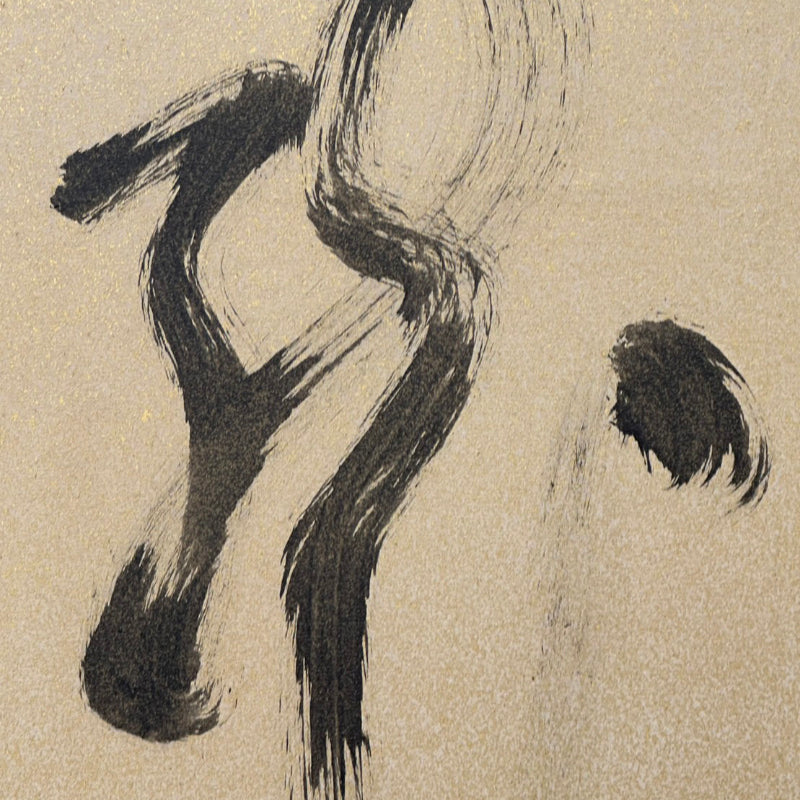6 panel Screen Pair, Immortal Pine ー福田 古道人 "六曲一双 老松"
6 panel Screen Pair, Immortal Pine ー福田 古道人 "六曲一双 老松"
Item Code: 古41
Since this product is an oversized item that requires custom shipping, please send us a message with the delivery address and we will come back to you with a shipping quote.
Contact form
A pair of rare Six Panel Screens opposing calligraphic verse with a painting of a solitary pine by Fukuda Kodojin. Rendered with expressive, calligraphic brushwork, the pine—a classic emblem of steadfastness and integrity—is depicted with bold, almost sculptural vigor. Kodojin’s brush alternates between dry, rugged strokes that describe the gnarled bark and sweeping wet washes that soften the contours, evoking both age and vitality. Against the luminous gold ground, the pine emerges not merely as a botanical study but as an embodiment of the literati ideal—enduring, solitary, and attuned to stillness. The sparse composition leaves vast negative space, emphasizing the painting’s meditative quality. Kodojin’s inscription, which appears to read Visited by an Immortal, lightly placed at the lower right, completes the poetic atmosphere of transcendence. The companion screen bears a long poetic inscription, its calligraphy as fluid and expressive as the pine’s linework. The verse, written in Kodojin’s distinctive semi-cursive hand, moves rhythmically across the six panels, breathing with pauses and accelerations that mirror the inner cadence of thought. The brush alternates between moments of dense, ink-laden force and airier, dancing traces, revealing a unity between writing and painting that defines Kodojin’s mature style. Together, these screens represent the bunjin (literati) synthesis of painting and poetry. The painting embodies the poem’s spirit; the poem articulates the painting’s silence. Ink and applied gold on paper, the screens measure 369 x 171.5 cm each (roughly 145 x 67-1/2 inches). There is some loss to the paper surface from rubbing together on the inside hinges, otherwise the screens are in decidedly excellent condition.
Fukuda Kodojin (1865-1944) was an eccentric self-taught artist, his status as a poet, calligrapher and literati artist has reached legendary status. Born at a time of great change (4 years before the final fall of the Edo Government), he lived through the westernization of Meiji, Taisho Democracy, the rise of Imperialism and final defeat of the Showa eras. He was part of a small group of artists existing outside conventional circles in pre-war Japan. He moved to a village outside of Kyoto in 1901, where he supported himself and his family by privately tutoring those who wished to learn Chinese-style poetry. Kodojin was simply a scholar. His poetry, painting, and calligraphy all stem from a life-long cultivation of the mind. He was said to have taken the time just before his death to destroy the large portion of his own remaining work, leaving only that which must have met some personal criteria. Kodōjin’s paintings and calligraphy survive mainly in private collections, but significant works can be found in the collections of the British Museum, Freer Sackler Gallery of the Smithsonian Institute, Honolulu Museum of Art, Houston Museum of Fine Arts, Kumamoto Prefectural Museum of Art, Minneapolis Institute of Art, Museo Kaluz, New York Metropolitan Museum of Art, Portland Art Museum, Seattle Art Museum, St. Louis Art Museum, Tanabe City Museum of Art and Wakayama Prefectural Museum of Art among others including such well known Private collections as the Cowles Collection, Hakutakuan Collection, Manyoan Collection and Welch Collection. Twenty five paintings by the artist formed a private exhibition (from the Gitter-Yelen collection) at the New Orleans Museum of Art in 2000. In recent years, exhibitions such as The Last Master of the Literati Tradition: Fukuda Kodōjin (Minneapolis Institute of Art, 2023) have brought renewed attention to his achievement. For more on his life see the book Old Taoist, or Unexplored Avenues of Japanese Painting.
Share
































